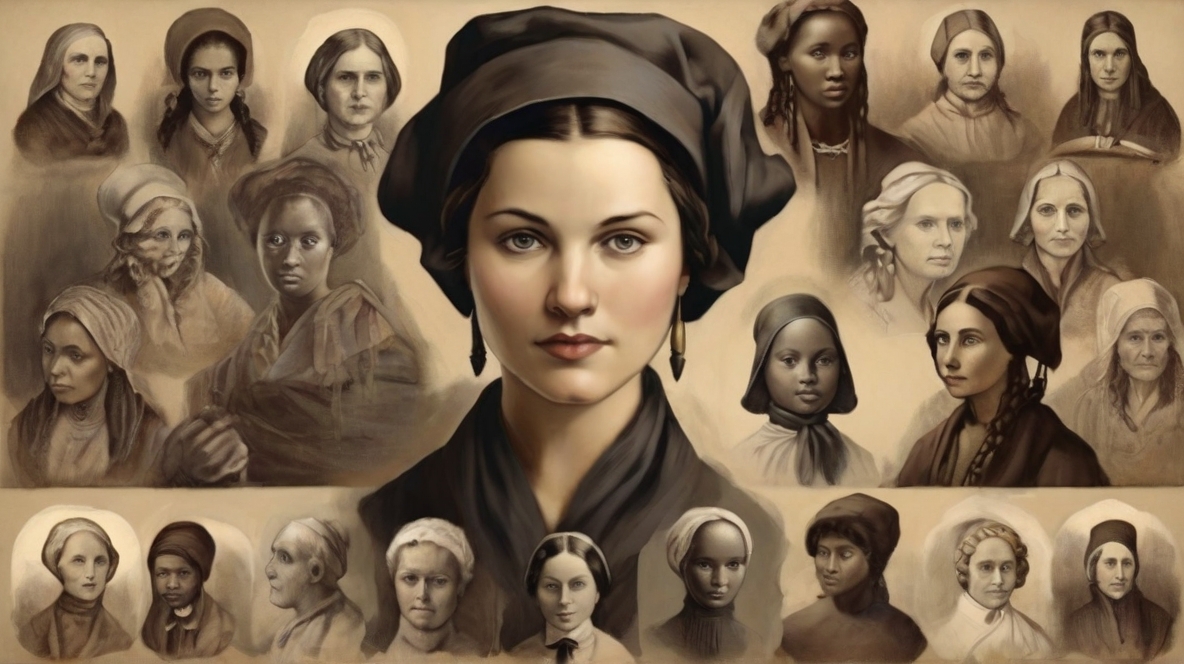History is a tapestry woven with the stories of extraordinary individuals who shaped the course of humanity. Yet, many of these narratives have often overlooked the remarkable contributions of women. In this exploration, we embark on a journey through time to rediscover the forgotten women of history—pioneers who, against societal odds, left an indelible mark in various fields. Their stories not only challenge stereotypes but also illuminate the diverse roles women have played in shaping our world.
I. Women in Science: Unlocking the Secrets of the Universe
A. Emilie du Châtelet (1706–1749): The Mathematical Trailblazer
Emilie du Châtelet (1706–1749) was a pioneering French mathematician, physicist, and author who made significant contributions to the fields of mathematics and physics during the 18th century. Her life was marked by intellectual curiosity, a passion for learning, and a commitment to breaking gender barriers. Here is an exploration of Emilie du Châtelet’s life and her notable contributions:
Emilie’s most renowned work is her translation of Sir Isaac Newton’s “Principia Mathematica” from Latin to French. What set her translation apart was the inclusion of her own extensive commentary, making Newton’s complex ideas more accessible to a French audience.
Emilie made groundbreaking contributions to physics, particularly in the understanding of energy conservation. Her work on the conservation of energy and dynamics laid the groundwork for future developments in the field.
Emilie collaborated with the renowned philosopher Voltaire, fostering a partnership that extended beyond intellectual endeavors. Their relationship was marked by mutual respect and a shared passion for science and philosophy.
Emilie du Châtelet’s contributions to mathematics and physics had a lasting impact on these fields. Her insightful commentary on Newton’s work and her independent research solidified her place as a respected scholar.
B. Lise Meitner (1878–1968): The Unsung Hero of Nuclear Fission
Lise Meitner (1878–1968) was an Austrian-Swedish physicist who played a pivotal role in the discovery of nuclear fission, one of the most significant breakthroughs in the field of nuclear physics. Despite facing gender-based challenges in her career, Meitner’s contributions laid the foundation for advancements in nuclear science and paved the way for the development of atomic energy. Here is an exploration of Lise Meitner’s life and her remarkable contributions:
In 1918, Meitner and Hahn discovered the element protactinium, a significant achievement that added to their growing reputation in the scientific community.
Meitner’s most significant contribution came in the 1930s when she, along with Otto Hahn and Fritz Strassmann, conducted experiments that led to the discovery of nuclear fission. This groundbreaking work laid the groundwork for the development of nuclear reactors and atomic weapons.
Despite being overlooked for the Nobel Prize in Chemistry awarded to Hahn in 1944 for their work on nuclear fission, Meitner received recognition for her contributions later in life. She was awarded numerous honors, including the naming of element 109 as “meitnerium” in her honor.
Lise Meitner’s contributions to nuclear physics gained wider acknowledgment after her death. In 1992, the element with atomic number 109 was officially named meitnerium, recognizing her role in the discovery of nuclear fission.
Lise Meitner’s journey from Vienna to Berlin, her collaborations with Otto Hahn, and her significant role in the discovery of nuclear fission mark her as a trailblazer in the field of nuclear physics. Her contributions, though initially overshadowed, have rightfully earned her a place among the pioneers of 20th-century physics.
II. Women in Mathematics: Navigating Numbers and Beyond
A. Sofia Kovalevskaya (1850–1891): The Trailblazing Mathematician
Sofia Kovalevskaya (1850–1891) was a pioneering Russian mathematician, known for her groundbreaking contributions to mathematics and for being the first woman to obtain a doctorate in mathematics. Her life was marked by a relentless pursuit of knowledge, overcoming societal barriers, and making lasting contributions to the field. Let’s examine the remarkable life of Sofia Kovalevskaya:
In 1874, Sofia Kovalevskaya completed her doctoral dissertation titled “On the Problem of the Rotation of a Solid Body about a Fixed Point.” She earned her doctorate from the University of Göttingen, becoming the first woman in history to obtain a doctorate in mathematics.
Kovalevskaya made significant contributions to the fields of analysis, mathematical physics, and mechanics. Her work on partial differential equations and the motion of rigid bodies with an invariant point became foundational in these areas.
Despite her academic achievements, Kovalevskaya faced challenges in securing academic positions due to gender discrimination. She held various positions, including a lecturer at the University of Stockholm.
Sofia Kovalevskaya’s life was tragically cut short when she died of influenza in 1891 at the age of 41. Despite the challenges she faced, her legacy endured, and her contributions continued to inspire future generations of mathematicians.Sofia Kovalevskaya’s legacy goes beyond her groundbreaking mathematical contributions; she stands as a trailblazer for women in mathematics and science. Her determination to pursue education and research, despite societal constraints, opened doors for future generations of women in STEM fields. Her life serves as an enduring testament to the power of passion, resilience, and intellectual curiosity.
B. Hypatia of Hypatia (c. 360–415 CE): Ancient Alexandria’s Scholar
Hypatia of Hypatia (c. 360–415 CE) was a prominent mathematician, philosopher, and astronomer who lived in ancient Alexandria, a city known for its intellectual and cultural vibrancy. Hypatia’s life and contributions have become legendary, and her story provides a glimpse into the intellectual climate of late antiquity. Let’s journey back to ancient Alexandria and explore the life of Hypatia:
Hypatia became a renowned teacher in Alexandria, attracting students from various backgrounds. Her lectures covered a wide range of subjects, including mathematics, astronomy, and philosophy. Her teachings emphasized Neoplatonism, a philosophical school that drew from the ideas of Plato.
Hypatia is known for her commentaries on the works of earlier mathematicians, particularly those of Ptolemy and Diophantus. Her commentaries helped preserve and disseminate mathematical knowledge from classical antiquity.
Hypatia lived during a period when the Library of Alexandria, once a center of knowledge in the ancient world, was in decline. The library’s destruction had lasting implications for the preservation of ancient texts and knowledge.
Hypatia’s life has been the subject of various historical and literary depictions. The 2009 film “Agora” provides a dramatized account of her life and the events leading to her tragic demise.
Hypatia’s life reflects the intellectual richness of ancient Alexandria and the challenges faced by scholars during a time of religious and political upheaval. Her contributions to mathematics, philosophy, and astronomy, along with her tragic end, have left an indelible mark on history. Hypatia’s story continues to captivate the imagination, reminding us of the importance of intellectual pursuits and the pursuit of knowledge even in tumultuous times.
III. Women in the Arts: Weaving Stories through Creativity
A. Artemisia Gentileschi (1593–1656): Baroque’s Fearless Painter
Artemisia Gentileschi (1593–1656) was a Baroque painter known for her powerful and evocative works, which often depicted strong, heroic women and mythological scenes. Born into a family of artists, Artemisia defied the conventions of her time, overcoming societal challenges and personal adversity to become a celebrated artist of the Baroque period. Let’s uncover the remarkable life of Artemisia Gentileschi:
Artemisia’s choice of subject matter set her apart from her male contemporaries. She often depicted strong and heroic women from history, mythology, and the Bible, challenging the traditional portrayal of passive female figures in art.
In recent years, there has been a renewed interest in Artemisia’s life and works. Art historians and scholars have reevaluated her contributions, recognizing her as a trailblazer who defied societal constraints and left an indelible mark on the history of art. Artemisia was known for her naturalistic and realistic approach to painting. Her skillful use of light and shadow, as well as her attention to emotional expression, added depth and intensity to her works.
Artemisia Gentileschi’s life and art challenge conventional narratives about women in the arts during the Baroque period. Her ability to overcome adversity and her groundbreaking depictions of women have earned her a lasting place in the canon of art history.
B. Florence Price (1887–1953): Pioneering Composer of the Harlem Renaissance
Florence Price (1887–1953) was a pioneering African-American composer whose musical contributions have left an enduring impact on American classical music. She is recognized for her unique blend of Western classical traditions and African-American folk influences, creating a distinct and vibrant musical voice. Let’s explore the musical contributions of Florence Price:
Florence Price’s music is known for its fusion of Western classical traditions and African-American musical elements. She skillfully incorporated spirituals, gospel, and the blues into her compositions, creating a unique and recognizable style.
Price often drew inspiration from African-American folklore and spirituals. This influence is evident in works like her Symphony in E minor, which incorporates spiritual themes and rhythms.
Florence Price’s Symphony in E minor made history when it was performed by the Chicago Symphony Orchestra in 1933, making her the first African-American woman to have a composition played by a major orchestra. The symphony blends classical forms with African-American melodies and rhythms.
Florence Price faced racial and gender discrimination during her lifetime, but her talent and perseverance earned her recognition. Despite the challenges, she received awards and accolades for her compositions, including the Wanamaker Prize for her Symphony in E minor. Florence Price’s musical legacy stands as a testament to her resilience, creativity, and ability to transcend social and cultural barriers. Her contributions have played a crucial role in expanding the narrative of American classical music, ensuring that her impact is recognized and celebrated by future generations.
The forgotten women of history, whose stories are too often relegated to the shadows, have played pivotal roles in shaping our world. From the realms of science and literature to mathematics and the arts, these remarkable pioneers defied societal norms, leaving legacies that continue to inspire. As we celebrate their accomplishments, let us recognize the importance of telling their stories and ensuring that the tapestry of history is woven with the threads of all those who contributed, regardless of gender. These women may have been forgotten, but their impact is everlasting, and their stories are integral to our shared human narrative.







